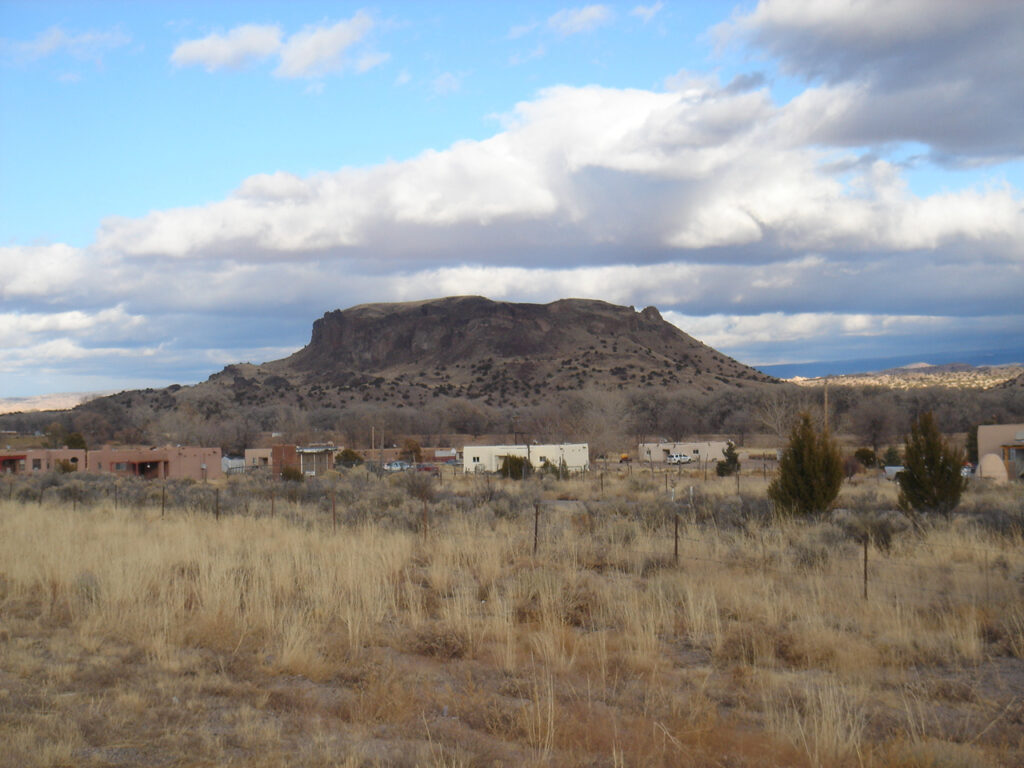A Short History of San Ildefonso Pueblo

San Ildefonso Pueblo is located about twenty miles northwest of Santa Fe, New Mexico, mostly on the eastern bank of the Rio Grande. Although their ancestry has been traced as far back as abandoned pueblos in the Mesa Verde area in southwestern Colorado, the most recent ancestral home of the people of San Ildefonso is in the area of Bandelier National Monument, the prehistoric village of Tsankawi in particular. The area of Tsankawi abuts today's reservation on its northwest side.
The San Ildefonso name was given to the village in 1617 when a mission church was established. Before then the village was called Powhoge, "where the water cuts through" (in Tewa). The village is at the northern end of the deep and narrow White Rock Canyon of the Rio Grande. Today's pueblo was established as long ago as the 1300s and when the Spanish arrived in 1540 they estimated the village population at about 2,000.
That first village mission was destroyed during the Pueblo Revolt of 1680 and when Don Diego de Vargas returned to reclaim the San Ildefonso area in 1694, he found virtually the entire tribe on top of nearby Black Mesa, along with almost all of the Northern Tewas from the various pueblos in Tewa Basin. After an extended siege, the Tewas and the Spanish negotiated a treaty and the people returned to their villages. However, the next 250 years were not good for any of them.
The Spanish swine flu pandemic of 1918 reduced San Ildefonso's population to about 90. The tribe's population has increased to more than 600 today but the only economic activity available for most on the pueblo involves the creation of art in one form or another. The only other jobs are off-pueblo. San Ildefonso's population is small compared to neighboring Santa Clara Pueblo, but the pueblo maintains its own religious traditions and ceremonial feast days.

Photo is in the public domain
About the Pottery of San Ildefonso Pueblo
Up into the early 1900s San Ildefonso pottery was mostly polychrome: red and black decorations painted on a cream background. Then archaeologist Edgar Hewitt came to the pueblo looking for someone to recreate some black pottery for him.
Hewitt had been excavating at Tsankawi, an ancient village of the people who migrated closer to the Rio Grande and became the San Ildefonso about 500 years before. At Tsankawi he'd found pieces of black pottery. He wanted to find a descendant of those people who could recreate similar black pottery. As he asked around the village, everyone pointed him to Maria Martinez. She turned out to be the right person in the right place at the right time. She didn't know herself how to make black pottery but she knew who to ask.
When Hewitt returned a couple years later, she had black pottery to show him. She wasn't happy with it but he was. He brought visitors who bought all the black pottery she had. Then Maria's husband Julian figured out how to make and use an organic paint that fired matte black. Within a few years, Maria and Julian were making history with their black-on-black pottery.
In the 1920s the market for black-on-black pottery exploded and Maria taught many of the pueblo women to make pottery. Painting was considered a man's job and many of those women had their husband's painting for them.
Black-on-black pottery is still a mainstay of San Ildefonso potters but there is also a significant amount of painted polychrome pottery and red and black pottery with carved and sgraffito designs being produced. Some San Ildefonso potters also like to inlay stones and strands of heishe beads in their pieces.
Our Info Sources
Pueblo Indian Pottery, 750 Artist Biographies, by Gregory Schaaf, © 2000, Center for Indigenous Arts & Studies.
Some information may have been gleaned from Pottery by American Indian Women: Legacy of Generations, by Susan Peterson, © 1997, Abbeville Press.
Some info may be sourced from Fourteen Families in Pueblo Pottery, by Rick Dillingham, © 1994, University of New Mexico Press, Albuquerque.
Other info may be derived from personal contacts with the potter and/or family members, old newspaper and magazine clippings, and through interminable searches of the Internet and cross-examination of any results returned.
Data is also checked against the Heard Museum's Native American Artists Resource Collection Online.
If you have any corrections or additional info for us to consider, please send it to: info@andreafisherpottery.com.